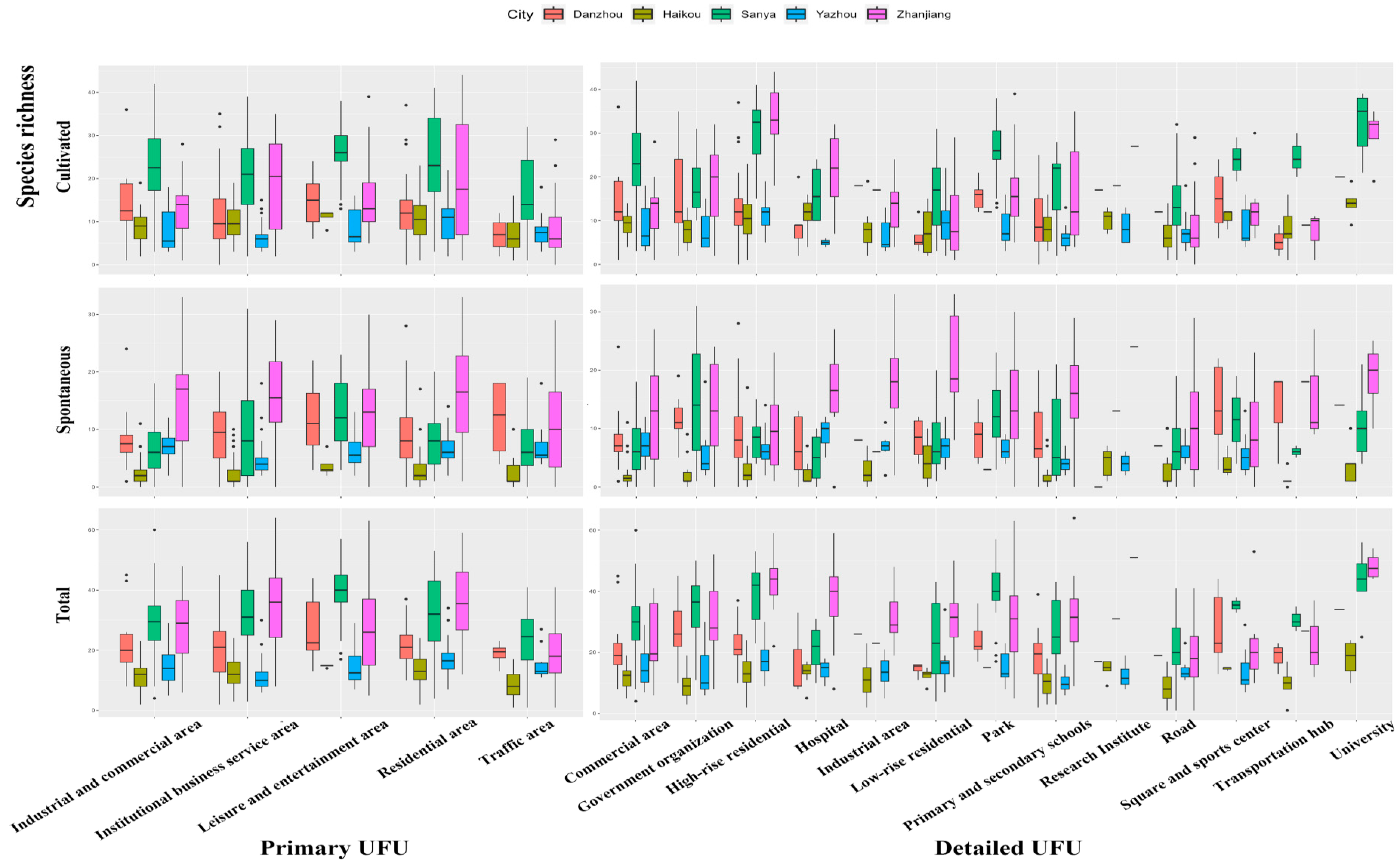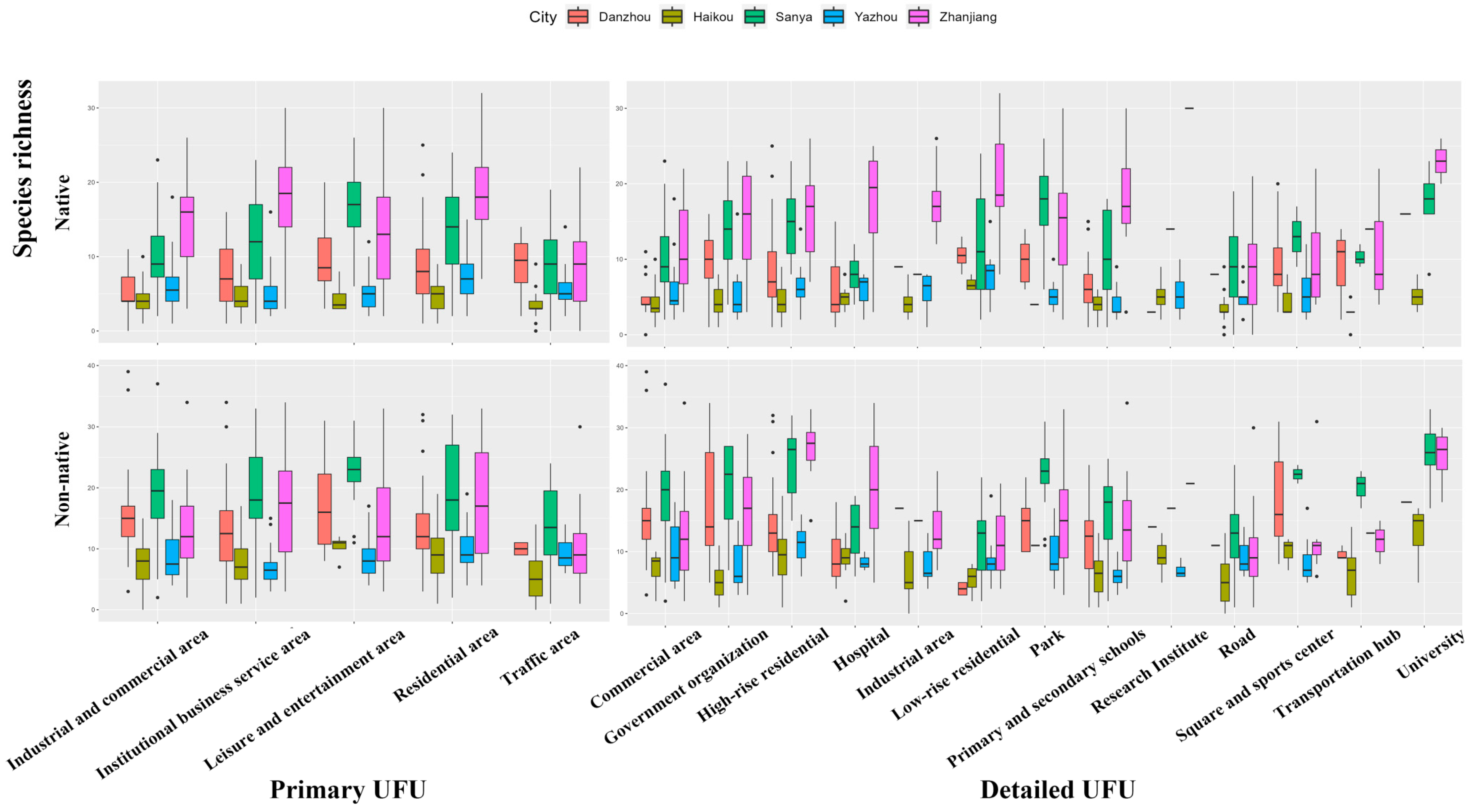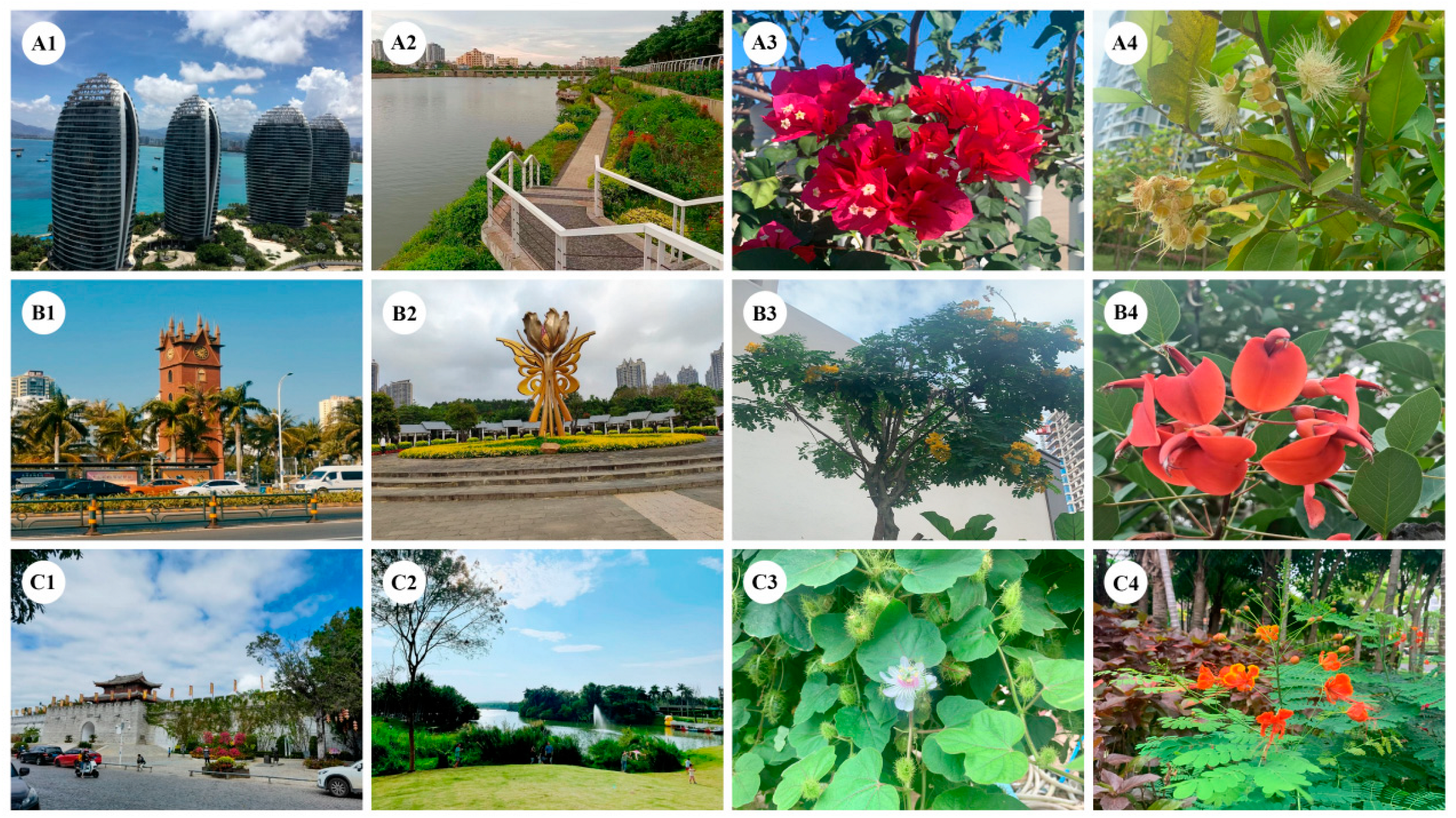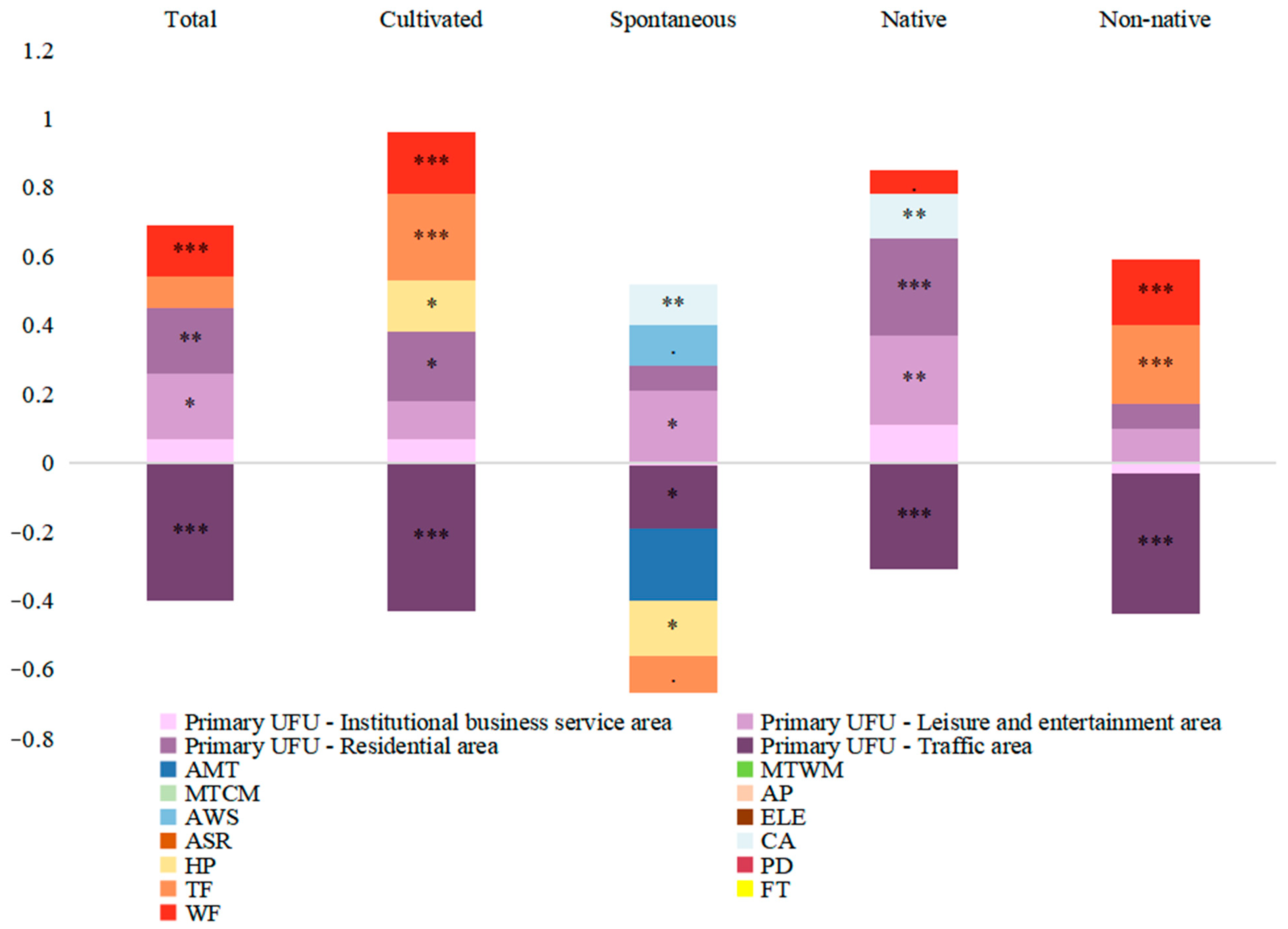Urban Planning and Green Landscape Management Drive Plant Diversity in Five Tropical Cities in China
Abstract
:1. Introduction
2. Materials and Methods
2.1. Study Area
2.2. Data Collection
2.2.1. Field Survey
2.2.2. Environment Variables
2.2.3. Socioeconomic Variables
2.3. Data Analysis
3. Results
3.1. Major UFUs Distribution
3.2. Plant Diversity Distribution Patterns


3.3. The Factors Affecting Urban Plant Diversity
| Total | Cultivated | Spontaneously Growing | Native | Non-Native | ||||||
|---|---|---|---|---|---|---|---|---|---|---|
| Random effects | ||||||||||
| Group Name | Variance | Std.Dev. | Variance | Std.Dev. | Variance | Std.Dev. | Variance | Std.Dev. | Variance | Std.Dev. |
| City (Intercept) | 0.40 | 0.63 | 0.43 | 0.65 | 0.33 | 0.56 | 0.34 | 0.59 | 0.43 | 0.66 |
| Residual | 0.40 | 0.63 | 0.46 | 0.68 | 0.44 | 0.66 | 0.41 | 0.64 | 0.48 | 0.69 |
| Number of obs: 733, groups: City, 5 | ||||||||||
| Fixed effects | ||||||||||
| β coefficient | β coefficient | β coefficient | β coefficient | β coefficient | ||||||
| (Intercept) | −0.13 | −0.07 | −0.09 | −0.17 | −0.04 | |||||
| Primary UFU—Institutional business service area | 0.07 | 0.07 | −0.01 | 0.11 | −0.03 | |||||
| Primary UFU—Leisure and entertainment area | 0.19 * | 0.11 | 0.21 * | 0.26 ** | 0.10 | |||||
| Primary UFU—Residential area | 0.19 ** | 0.20 * | 0.07 | 0.28 *** | 0.07 | |||||
| Primary UFU—Traffic area | −0.40 *** | −0.43 *** | −0.18 * | −0.31 *** | −0.41 *** | |||||
| Annual mean temperature | - | - | −0.21 | - | - | |||||
| Annual wind speed | - | - | 0.12 . | - | - | |||||
| Construction age (year) | - | - | 0.12 ** | 0.13 ** | - | |||||
| Housing price (Yuan) | - | 0.15 * | −0.16 * | - | - | |||||
| Trimming frequency (times/year) | 0.09 | 0.25 *** | −0.11 . | - | 0.23 *** | |||||
| Watering frequency (times/year) | 0.15 *** | 0.18 *** | - | 0.07 . | 0.19 *** | |||||
| AIC | 1441.6 | 1547.3 | 1517.7 | 1453.4 | 1570.9 | |||||
4. Discussion
4.1. Socioeconomic Factors Dominate Urban Plant Diversity
4.2. Effect of Land Use Type on Plant Diversity
5. Conclusions
Supplementary Materials
Author Contributions
Funding
Institutional Review Board Statement
Informed Consent Statement
Data Availability Statement
Conflicts of Interest
References
- Ma, S.J.; Wang, R.S. Socio-economic-natural complex ecosystems. J. Ecol. 1984, 4, 1–9. [Google Scholar]
- Wang, R.S.; Liu, J.R. Urban ecology and ecological habitat construction. J. Mod. Urban Res. 2010, 3, 28–31. [Google Scholar]
- Hobbie, S.E.; Grimm, N.B. Nature-based approaches to managing climate change impacts in cities. Philos. Trans. R. Soc. B 2020, 375, 20190124. [Google Scholar] [CrossRef] [PubMed] [Green Version]
- Elmqvist, T.; Fragkias, M.; Goodness, J.; Güneralp, B.; Marcotullio, P.J.; McDonald, R.I.; Seto, K.C. Urbanization, Biodiversity and Ecosystem Services: Challenges and Opportunities: A Global Assessment; Springer: Berlin/Heidelberg, Germany, 2013. [Google Scholar]
- Muller, N.; Werner, P.; Kelcey, J.G. Urban Biodiversity and Design; John Wiley & Sons: Hoboken, NJ, USA, 2010. [Google Scholar]
- Escobedo, F.J.; Giannico, V.; Jim, C.Y.; Sanesi, G.; Lafortezza, R. Urban forests, ecosystem services, green infrastructure and nature-based solutions: Nexus or evolving metaphors? Urban For. Urban Green. 2019, 37, 3–12. [Google Scholar] [CrossRef]
- Semeraro, T.; Scarano, A.; Buccolieri, R.; Santino, A.; Aarrevaara, E. Planning of urban green spaces: An ecological perspective on human benefits. Land 2021, 10, 105. [Google Scholar] [CrossRef]
- Jim, C.Y.; Chen, W.Y. Assessing the ecosystem service of air pollutant removal by urban trees in Guangzhou (China). J. Environ. Manag. 2008, 88, 665–676. [Google Scholar] [CrossRef]
- Nowak, D.J.; Crane, D.E. Carbon Storage and Sequestration by Urban Trees in the USA. Environ. Pollut. 2002, 116, 381–389. [Google Scholar] [CrossRef]
- Cheng, X.L.; Cubino, J.P.; Balfour, K.; Zhu, Z.X.; Wang, H.F. Drivers of spontaneous and cultivated species diversity in the tropical city of Zhanjiang, China. Urban For. Urban Green. 2022, 67, 127428. [Google Scholar] [CrossRef]
- Liu, H.; Ren, M.X.; Richards, J.; Song, X.Q. Tropical China Plant diversity, Ecology and Conservation—A Glimpse at the Current State. Bot. Rev. 2017, 83, 1–4. [Google Scholar] [CrossRef]
- Lepczyk, C.A.; Aronson, M.F.; Evans, K.L.; Goddard, M.A.; Lerman, S.B.; MacIvor, J.S. Biodiversity in the city: Fundamental questions for understanding the ecology of urban green spaces for biodiversity conservation. BioScience 2017, 67, 799–807. [Google Scholar] [CrossRef] [Green Version]
- Chang, C.R.; Chen, M.C.; Su, M.H. Natural versus human drivers of plant diversity in urban parks and the anthropogenic species-area hypotheses. Landsc. Urban Plan. 2021, 208, 104023. [Google Scholar] [CrossRef]
- Irl, S.D.; Harter, D.E.; Steinbauer, M.J.; Gallego Puyol, D.; Fernández-Palacios, J.M.; Jentsch, A.; Beierkuhnlein, C. Climate vs. topography–spatial patterns of plant species diversity and endemism on a high-elevation island. J. Ecol. 2015, 103, 1621–1633. [Google Scholar] [CrossRef]
- Kessler, M.; Kluge, J.; Hemp, A.; Ohlemüller, R. A global comparative analysis of elevational species richness patterns of ferns. Glob. Ecol. Biogeogr. 2011, 20, 868–880. [Google Scholar] [CrossRef]
- Hope, D.; Gries, C.; Zhu, W.; Fagan, W.F.; Redman, C.L.; Grimm, N.B.; Nelson, A.L.; Martin, C.; Kinzig, A. Socioeconomics Drive Urban Plant diversity. Proc. Natl. Acad. Sci. USA 2003, 100, 8788–8792. [Google Scholar] [CrossRef] [PubMed]
- Avolio, M.L.; Pataki, D.E.; Trammell, T.L.E.; Endter-Wada, J. Biodiverse cities: The nursery industry, homeowners, and neighborhood differences drive urban tree composition. Ecol. Monogr. 2018, 88, 259–276. [Google Scholar] [CrossRef] [Green Version]
- Avolio, M.; Blanchette, A.; Sonti, N.F.; Locke, D.H. Time Is Not Money: Income Is More Important Than Lifestage for Explaining Patterns of Residential Yard Plant Community Structure and Diversity in Baltimore. Front. Ecol. Evol. 2020, 8, 85. [Google Scholar] [CrossRef] [Green Version]
- Cervelli, E.W.; Lundholm, J.T.; Du, X. Spontaneous urban vegetation and habitat heterogeneity in Xi’an. Landsc. Urban Plan. 2013, 120, 25–33. [Google Scholar] [CrossRef]
- Bonthoux, S.; Chollet, S.; Balat, I.; Voisin, L. Improving nature experience in cities: What are people’s preferences for vegetated streets? J. Environ. Manag. 2019, 230, 335–344. [Google Scholar] [CrossRef]
- Larson, J.L.; Kesheimer, A.J.; Potter, D.A. Pollinator assemblages on dandelions and white clover in urban and suburban lawns. J. Insect Conserv. 2014, 18, 863–873. [Google Scholar] [CrossRef]
- Yang, F.; Ignatieva, M.; Wissman, J.; Zhu, S. Relationships between multi-scale factors, plant and pollinator diversity, and composition of park lawns and other herbaceous vegetation in a fast growing megacity of China. Landsc. Urban Plan. 2019, 185, 117–126. [Google Scholar] [CrossRef]
- Huang, L.; Qian, S.; Li, T.; Yang, Y.C. Masonry walls as sieve of urban plant assemblages and refugia of native species in Chongqing, China. Landsc. Urban Plan. 2019, 191, 103620. [Google Scholar] [CrossRef]
- Smith, L.S.; Fellowes, M.D.E. The grass-free lawn: Management and species choice for optimum ground cover and plant diversity. Urban For. Urban Green. 2014, 13, 433–442. [Google Scholar] [CrossRef]
- Wang, H.-F.; Cheng, X.-L.; Nizamani, M.M.; Balfour, K.; Da, L.; Zhu, Z.-X.; Qureshi, S. An Integrated approach to study spatial patterns and drivers of land cover within urban functional units: A multi-city comparative study in China. Remote Sens. 2020, 12, 2201. [Google Scholar] [CrossRef]
- Zhang, H.-L.; Cubino, J.P.; Nizamani, M.M.; Harris, A.; Cheng, X.-L.; Da, L.; Sun, Z.; Wang, H.-F. Wealth and land use drive the distribution of urban green space in the tropical coastal city of haikou, china. Urban For. Urban Green. 2022, 71, 127554. [Google Scholar] [CrossRef]
- Wang, H.F.; Qiu, J.X.; Breuste, J.; Friedman, R.C.; Zhou, W.Q.; Wang, X.K. Variations of urban greenness across urban structural units in Beijing, China. Urban For. Urban Green. 2013, 12, 554–561. [Google Scholar] [CrossRef]
- Anderson, J.R.; Hardy, E.E.; Roach, J.T. A land use and land cover classification system for use with remote sensor data. Prof. Pap. Geol. Surv. 1976, 964, 1–28. [Google Scholar]
- Wang, H.F.; Qureshi, S.; Knapp, S.; Friedman, C.R.; Hubacek, K. A basic assessment of residential plant diversity and its ecosystem services and disservices in Beijing, China. Appl. Geogr. 2015, 64, 121–131. [Google Scholar] [CrossRef]
- Nizamani, M.M.; Harris, A.J.; Cheng, X.L.; Zhu, Z.X.; Jim, C.Y.; Wang, H.F. Positive relationships among aboveground biomass, tree species diversity and urban greening management in tropical coastal city of Haikou. Ecol. Evol. 2021, 11, 12204–12219. [Google Scholar] [CrossRef]
- FAO. The Global Forest Resources Assessment 2000 (FRA 2000): Terms and Definitions; FAO: Rome, Italy, 1998. [Google Scholar]
- UNECE/FAO. Forest Resources of Europe, CIS, North America, Australia, Japan and New Zealand; United Nations: New York, NY, USA, 2000. [Google Scholar]
- Chen, H.Y. Botany of Hainan; Science Press: Beijing, China, 1964. [Google Scholar]
- He, J. Exotic Plants in China; Shanghai Science and Technology Press: Shanghai, China, 2012; p. 761. [Google Scholar]
- Ma, J.S.; Yan, X.L.; Shou, H.Y. The Checklist of the Chinese Invasive Plants; China Higher Education Press: Beijing, China, 2013. [Google Scholar]
- Fick, S.E.; Hijmans, R.J. WorldClim 2: New 1 km spatial resolution climate surfaces for global land areas. Int. J. Climatol. 2017, 37, 4302–4315. [Google Scholar] [CrossRef]
- Gao, Z.W.; Pan, Y.J.; Peter, M.V.B.; Ellen, C.; Xing, D.L.; Yang, Y.Y.; Xia, T.Y.; Luo, X.Y.; Song, K.; Da, L.J.; et al. Beta diversity of urban spontaneous plants and its drivers in 9 major cities of Yunnan province, China. Landsc. Urban Plan. 2023, 234, 104741. [Google Scholar] [CrossRef]
- Menard, S. Applied Logistic Regression Analysis; Sage: Washington, DC, USA, 2002. [Google Scholar]
- Vittinghoff, E.; Glidden, D.V.; Shiboski, S.C.; McCulloch, C.E. Regression Methods in Biostatistics: Linear, Logistic, Survival, and Repeated Measures Models; Springer: Berlin/Heidelberg, Germany, 2006. [Google Scholar]
- Gareth, J.; Daniela, W.; Trevor, H.; Robert, T. An Introduction to Statistical Learning: With Applications in R; Spinger: Berlin/Heidelberg, Germany, 2013. [Google Scholar]
- Bates, D.; Maechler, M.; Bolker, B.; Walker, S. Fitting Linear Mixed-Effects Models Using lme4. J. Stat. Softw. 2015, 67, 1–48. [Google Scholar] [CrossRef]
- Wickham, H. ggplot2: Elegant Graphics for Data Analysis; Springer: New York, NY, USA, 2016. [Google Scholar]
- Aronson, M.F.; Nilon, C.; Lepczyk, C.; Zipperer, W. Hierarchical filters determine community assembly of urban species pools. Ecology 2016, 97, 2952–2963. [Google Scholar] [CrossRef] [PubMed] [Green Version]
- La Sorte, F.A.; Aronson, M.F.J.; Williams, N.S.G.; Celesti-Grapow, L.; Cilliers, S.; Clarkson, B.D.; Dolan, R.W.; Hipp, A.; Klotz, S.; Kühn, I.; et al. Beta diversity of urban floras. Glob. Ecol. Biogeogr. 2014, 23, 769–779. [Google Scholar] [CrossRef]
- Liu, J.J.; Yu, M.J.; Tomlinson, K.; Slik, J.W.F. Patterns and drivers of plant biodiversity in Chinese university campuses. Landsc. Urban Plan. 2017, 164, 64–70. [Google Scholar] [CrossRef]
- Harris, A.J.; Dee, J.; Palmer, M.W. The effects of taxonomic rank on climatic calibrations: A test using extant floras of United States counties. Rev. Palaeobot. Palynol. 2017, 244, 316–324. [Google Scholar] [CrossRef]
- Cheval, S.; Dumitrescu, A.; Adamescu, M.; Cazacu, C. Identifying climate change hotspots relevant for ecosystems in Romania. Clim. Res. 2020, 80, 165–173. [Google Scholar] [CrossRef]
- Mcfadden, I.R.; Sandel, B.; Tsirogiannis, C.; Morueta-Holme, N.; Svenning, J.; Enquist, B.J.; Kraft, N.J. Temperature shapes opposing latitudinal gradients of plant taxonomic and phylogenetic β diversity. Ecol. Lett. 2019, 22, 1126–1135. [Google Scholar] [CrossRef]
- Li, J.; Fan, G.; He, Y. Predicting the current and future distribution of three Coptis herbs in China under climate change conditions, using the MaxEnt model and chemical analysis. Sci. Total Environ. 2020, 698, 134141. [Google Scholar] [CrossRef]
- Korell, L.; Auge, H.; Chase, J.M.; Harpole, W.S.; Knight, T.M. Responses of plant diversity to precipitation change are strongest at local spatial scales and in drylands. Nat. Commun. 2021, 12, 2489. [Google Scholar] [CrossRef]
- Kendal, D.; Williams, N.; Williams, K. A cultivated environment: Exploring the global distribution of plants in gardens, parks and streetscapes. Urban Ecosyst. 2012, 15, 637–652. [Google Scholar] [CrossRef]
- Leong, M.; Dunn, R.R.; Trautwein, M.D. Biodiversity and socioeconomics in the city: A review of the luxury effect. Biol. Lett. 2018, 14, 20180082. [Google Scholar] [CrossRef] [Green Version]
- Walker, J.S.; Grimm, N.B.; Briggs, J.M.; Gries, C.; Dugan, L. Effects of urbanization on plant species diversity in central Arizona. Front. Ecol. Environ. 2009, 7, 465–470. [Google Scholar] [CrossRef]
- Szlavecz, K.; Warren, P.; Pickett, S.T.A. Biodiversity on the urban landscape. In Human Population: Its Influences on Biological Diversity, Ecological Studies; Cincotta, R.P., Gorenflo, L.J., Eds.; Springer: New York, NY, USA, 2011; pp. 75–101. [Google Scholar]
- Faeth, S.H.; Warren, P.S.; Shochat, E.; Marussich, W.A. Trophic dynamics in urban communities. BioScience 2005, 55, 399. [Google Scholar] [CrossRef]
- Dow, K. Social dimensions of gradients in urban ecosystems. Urban Ecosyst. 2000, 4, 255–275. [Google Scholar] [CrossRef]
- Yang, J.; Yan, P.; He, R.; Song, X. Exploring land-use legacy effects on taxonomic and functional diversity of woody plants in a rapidly urbanizing landscape. Landsc. Urban Plan. 2017, 162, 92–103. [Google Scholar] [CrossRef]
- Helm, J.; Dutoit, T.; Saatkamp, A.; Bucher, S.F.; Leiterer, M.; Römermann, C. Recovery of Mediterranean steppe vegetation after cultivation: Legacy effects on plant composition, soil properties and functional traits. Appl. Veg. Sci. 2019, 22, 71–84. [Google Scholar] [CrossRef]
- Lubbe, C.S.; Siebert, S.J.; Cilliers, S.S. Political legacy of south africa affects the plant diversity patterns of urban domestic gardens along a socio-economic gradient. Sci. Res. Essays 2010, 5, 2900–2910. [Google Scholar]
- Clarke, L.W.; Jenerette, G.D.; Davila, A. The luxury of vegetation and the legacy of tree biodiversity in Los Angeles, CA. Landsc. Urban Plan. 2013, 116, 48–59. [Google Scholar] [CrossRef]
- Larson, K.L.; Hoffman, J.; Ripplinger, J. Legacy effects and landscape choices in a desert city. Landsc. Urban Plan. 2017, 165, 22–29. [Google Scholar] [CrossRef]
- Roman, L.A.; Pearsall, H.; Eisenman, T.S.; Conway, T.M.; Fahey, R.T.; Landry, S.; Vogt, J.; van Doorn, N.S.; Grove, J.M.; Locke, D.H.; et al. Human and biophysical legacies shape contemporary urban forests: A literature synthesis. Urban For. Urban Green. 2018, 31, 157–168. [Google Scholar] [CrossRef]
- Larson, K.L.; Nelson, K.C.; Samples, S.R.; Hall, S.J.; Bettez, N.; Cavender-Bares, J.; Groffman, P.M.; Grove, M.; Heffernan, J.B.; Hobbie, S.E.; et al. Ecosystem services in managing residential landscapes: Priorities, value dimensions, and cross-regional patterns. Urban Ecosyst. 2016, 19, 95–113. [Google Scholar] [CrossRef]
- Zhang, N. Landscape Ecology; Science Press: Beijing, China, 2017. [Google Scholar]
- Ramer, H.; Nelson, K.C. Applying ‘action situation’concepts to public land managers’ perceptions of flowering bee lawns in urban parks. Urban For. Urban Green. 2020, 53, 126711. [Google Scholar] [CrossRef]
- Grafius, D.R.; Corstanje, R.; Harris, A.J. Linking ecosystem services, urban form and green space configuration using multivariate landscape metric analysis. Landsc. Ecol. 2018, 33, 557–573. [Google Scholar] [CrossRef] [Green Version]
- Braun, V. Arguments for Protected Areas Multiple Benefits for Conservation and Use, eco.mont. J. Prot. Mt. Areas Res. 2010, 3, 42. [Google Scholar]
- Hilborn, R.; Sinclair, A. Biodiversity protection in the 21st century needs intact habitat and protection from over exploitation whether inside or outside parks. Conserv. Lett. 2021, 14, e12830. [Google Scholar] [CrossRef]
- Hiemstra, J.A.; Saaroni, H.; Amorim, J.H. The Urban Heat Island: Thermal Comfort and the Role of Urban Greening. In Future City, The Urban Forest; Pearlmutter, D., Ed.; Springer: Cham, Switzerland, 2017; Volume 7. [Google Scholar] [CrossRef]
- Schwarz, N.; Moretti, M.; Bugalho, M.N.; Davies, Z.G.; Haase, D.; Hack, J.; Hof, A.; Melero, Y.; Pett, T.J.; Knapp, S. Understanding biodiversity-ecosystem service relationships in urban areas: A comprehensive literature review. Ecosyst. Serv. 2017, 27, 161–171. [Google Scholar] [CrossRef] [Green Version]
- Berland, A.; Shiflett, S.A.; Shuster, W.D.; Garmestani, A.S.; Goddard, H.C.; Herrmann, D.L.; Hopton, M.E. The role of trees in urban stormwater management. Landsc. Urban Plan. 2017, 162, 167–177. [Google Scholar] [CrossRef] [Green Version]
- Ma, B.; Zhou, T.; Lei, S.; Wen, Y.; Htun, T.T. Effects of urban green spaces on residents’ well-being. Environ. Dev. Sustain. 2019, 21, 2793–2809. [Google Scholar] [CrossRef]



Disclaimer/Publisher’s Note: The statements, opinions and data contained in all publications are solely those of the individual author(s) and contributor(s) and not of MDPI and/or the editor(s). MDPI and/or the editor(s) disclaim responsibility for any injury to people or property resulting from any ideas, methods, instructions or products referred to in the content. |
© 2023 by the authors. Licensee MDPI, Basel, Switzerland. This article is an open access article distributed under the terms and conditions of the Creative Commons Attribution (CC BY) license (https://creativecommons.org/licenses/by/4.0/).
Share and Cite
Cui, J.; Zhu, M.; Guo, L.; Zhang, H.; Hughes, A.C.; Wang, H. Urban Planning and Green Landscape Management Drive Plant Diversity in Five Tropical Cities in China. Sustainability 2023, 15, 12045. https://doi.org/10.3390/su151512045
Cui J, Zhu M, Guo L, Zhang H, Hughes AC, Wang H. Urban Planning and Green Landscape Management Drive Plant Diversity in Five Tropical Cities in China. Sustainability. 2023; 15(15):12045. https://doi.org/10.3390/su151512045
Chicago/Turabian StyleCui, Jianpeng, Meihui Zhu, Linyuan Guo, Haili Zhang, Alice C. Hughes, and Huafeng Wang. 2023. "Urban Planning and Green Landscape Management Drive Plant Diversity in Five Tropical Cities in China" Sustainability 15, no. 15: 12045. https://doi.org/10.3390/su151512045
APA StyleCui, J., Zhu, M., Guo, L., Zhang, H., Hughes, A. C., & Wang, H. (2023). Urban Planning and Green Landscape Management Drive Plant Diversity in Five Tropical Cities in China. Sustainability, 15(15), 12045. https://doi.org/10.3390/su151512045








